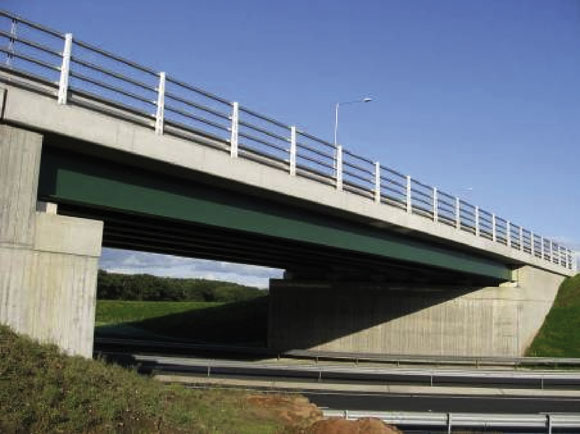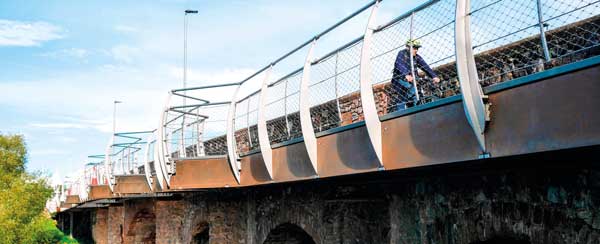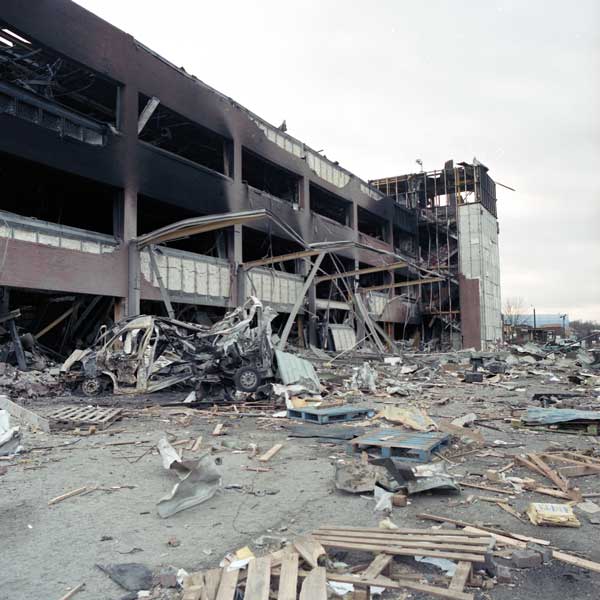Technical
Steel bridges – looking forward with the Eurocodes
David Iles, of the SCI, considers when UK bridge designers will start using the Eurocodes, how the process and the outcomes will differ from those with BS 5400 and how support is being provided.
The current market share for steel in highway and railway bridge construction in the UK has been developed under the influence of the Codes of Practice that make up BS 5400 and with specifications for materials, products and workmanship that were largely written in the UK. Designers and constructors have optimised their schemes and concepts using those rules, to show the wide-ranging benefits that steel can offer. But now the Structural Eurocodes are almost upon us – how soon can we make the transition and what will be the effect on the forms of construction, the economy and the advantages of steel? This review attempts to provide a perspective.
When can the Eurocodes be used for bridges?
All the relevant Eurocode Parts have been published for some time now and, in principle, steel and steel-concrete composite bridges can be designed in accordance with their rules and principles. However, the nature of the Eurocodes is that some aspects related to safety are left for individual national standards organisations to set parameters and choose options in their National Annexes. In the UK, many of those National Annexes are yet to be published; without them there are no definitive partial factors on actions (loads) and resistances and this has undoubtedly put a brake upon the introduction until now. But by the beginning of 2009, it is hoped that all the necessary National Annexes will have been published and design to the Eurocodes can then be fully implemented in the UK. However, BS 5400 will remain current until March 2010 and the use of the Eurocodes on specific bridge projects depends on the implementation by client authorities. It is understood that they will be publishing their implementation standard in May. Alongside the changeover, HA will be significantly reducing the number of documents under the umbrella of the Design Manual for Roads and Bridges and relying instead on a combination of Eurocode rules and industry standards. The RSSB has been actively participating in developing those parts of the UK National Annexes that relate to railway bridges, so the Eurocodes can be implemented for railway bridges as well, although we await advice from Network Rail on when they will accept designs to the Eurocodes.
What differences will the bridge designer find?
The first and most obvious difference that the designer will find is the number of documents and their size. The Structural Eurocodes are a comprehensive set of standards for steel, concrete, masonry, timber and aluminium structures, covering a wide range of structural forms, so there are very many Parts: for steel and concrete composite bridges the designer will need to refer to over 20 Eurocodes Parts, each with its National Annex. That may sound formidable but there any parallels to BS 5400 – it had one part to set out the design basis, one to set out the design loads (actions), one for steel elements, one for concrete elements, one for the composite interaction between steel and concrete elements and these are all mirrored in the Eurocodes.
In detail, the designer will find a much more comprehensive design basis that sets out the variety of design situations that must be considered. This range of situations includes, for example, accidental design situations, which were not covered by BS 5400 (designers familiar with the DMRB will recognise some of those requirements and the actions appropriate to them). The combinations of coexisting actions are more thoroughly set out. Although traffic loads will look a little different, the National Annex values have been calibrated to give values of bending moments and shears that are very close to those given by BS 5400. The principles for design of steel elements and their connections are broadly similar although they are less empirical; the most notable ‘omission’ is the determination of lateral torsional buckling slenderness – designers will need to resort to other sources for ‘simple’ rules or to a 3D buckling analysis. Composite design deals more thoroughly with the global behaviour of the steel girder plus composite deck form and introduces concepts such as tension stiffening that will take a little while to appreciate. References are made to material and product standards and to ‘execution’ specifications such as EN 1090-2 (which will be discussed further below).
What won’t change?
Broadly, the overall cost and form of steel and composite bridges are unlikely to change as a result of the introduction of the Eurocodes. This is largely because BS 5400 was already a ‘modern’ standard and the partial factors in the UK National Annexes have been calibrated to give the same level of reliability (‘margin of safety’) as with BS 5400. The sustainability benefits of steel construction will be unaffected and the advantages of off-site construction and rapid erection will remain (see inset). Grade S355 steel will continue to be the most economic choice in most situations; weathering steel will continue to offer a popular, attractive and economic alternative to protective treatment (see inset).
What is the steel industry doing to assist with the changeover?
Assistance is being provided through SCI thanks to sponsorship by Corus and to the contribution of best practice advice from the Steel Bridge Group.
SCI is updating its well-respected range of bridge design guides: the replacement for the highway bridge design guide will be published shortly and a worked examples publication will follow in 2009. Updated guides for box girder bridges and railway bridges will follow in 2009-2010 and a new footbridge guide will be written. All publications are reviewed by the Steel Bridge Group during drafting.
SCI has taken over the running of the twice-yearly steel bridge design course (formerly run by Corus) and the Steel Bridge Group’s annual advanced bridge design course. The twice-yearly course has been remodelled to reflect to the influence of the Eurocodes and to introduce new speakers from industry who are actively involved in steel bridge design; the first event was successfully held in September and the second will take place in Leeds in November. The advanced course has been updated and provides general guidance on topics such as cable stayed bridges and tied arch bridges; the influence of Eurocodes on this course is modest.
SCI continues to run the student design competition for undergraduates. Each year a different bridge design brief is set and for detailed design a ‘simplified Eurocode’ is provided.
What is the Steel Bridge Group?
The Steel Bridge Group is an informal technical group of about 16 full members that was established in the 1990s to consider matters of high priority interest to the steel bridge construction industry and to suggest strategies for improving the use of steel in bridgework. All the members are senior engineers with long experience of the design and construction of steel bridges, The Group was responsible for producing a set of 60 Guidance Notes, giving best practice advice, that were issued as SCI publication P185. The Group also initiated the advanced bridge design course and provides the speakers for it. Recently the Group has turned its attention to the updating of its Guidance Notes and to the drafting of a Model Project Specification (MPS) to complement EN 1090-2.
What are EN 1090-2 and the MPS?
The execution standard for steelwork, EN 1090-2, is due to be published in the next month or so. It is a comprehensive specification that brings together all the requirements for the construction of steelwork, in all forms. Because EN 1090-2 is comprehensive it needs to be tailored to suit bridge steelwork, by the choice of optional and alternative requirements that are allowed by the standard. For bridges, a higher quality is usually demanded, because of the fatigue loading to which bridges are subjected. To achieve bridge-specific requirements the Steel Bridge Group has reviewed all the options and alternatives in EN 1090-2 and has drafted a Model Project Specification that provides clauses for incorporation into contract documents. Each clause is accompanied by a commentary giving its background and advice where further project-specific requirements might be added. The MPS is due to be published by the end of this year.
Why do the Guidance Notes need to be updated?
The Guidance Notes offer best practice advice to designers about many aspects of design that relate to practical matters concerning construction. As such, there is little guidance related to design rules for strength but many of the Notes relate to standards for products and materials. However, many of the relevant standards have changed in recent years, often with a change in emphasis or approach – the standards related to welding procedures and weld acceptance criteria in particular have changed significantly. Unless the changes are reflected in new Notes, the set will lose its value, so the Group is undertaking a thorough review of all the Notes and a new issue will be published in early 2009. The Notes will complement the MPS and there will be cross references between the two.
We’re ready – are you?
The transition period, from the time when all the National Annexes are available until the date for withdrawal of BS 5400 is not much more than a year. Although many organisations have started training engineers to design to the Eurocodes, there is much still to be learnt, and many lessons will only be learnt when the Eurocodes are used in real situations. The steel industry is providing guidance to assist the changeover – take advantage of it!
Weathering steel provides long-term environmental and economic benefits
Weathering steel, an alloy that does not need to be painted because it forms a tightly adherent surface ‘patina’, is being widely chosen for bridge structures. A typical example is the 510 m long dual carriageway Hunslet Viaduct in Leeds (pictured). Weathering steel was chosen in preference to the original choice of post-tensioned concrete because its appearance maintains the elegant S-shaped curve whilst offering an appearance that blends in with surrounding buildings. It also avoids the need for painting and repainting, with environmental and health and safety benefits, as well as achieving lower whole life costs.
Weathering steel has also been chosen for the Olympic Park bridges and the M74 extension.
Off-line bridge construction
Composite bridge superstructures are sufficiently light that they can in some cases be fully constructed off-line and then transported into position in a single night. An example of this technique has been used on the A1 in Nottinghamshire for three new overbridges. Pictured above is the completed overbridge at Apleyhead Junction, near Blyth. This 30m long bridge was assembled at low level near to its final location, complete with concrete deck, then the 550t structure was raised, transported on self-propelled modular transporters and lowered into position. The choice of composite construction minimised both the amount of material going to this busy site and the disruption of traffic.















